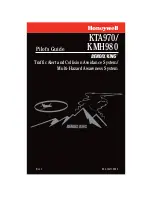
Rev 1 Mar/2000
KMD 150 Pilot's Guide
125
Cluster and Splattering Within 25 nm
Figure 13-13 shows the Stormscope screen in the 360° weather view at
the 25 nm range. One moderately active thunderstorm appears as a
cluster of discharge points at 8:30 centered 14 nm away with a splat-
tering of discharge points throughout the 25 nm range. Such splattering
is due to electrical discharges within 3 to 5 nm of the aircraft and indi-
cates that the aircraft is too close to the thunderstorm.
Figure 13-13 - Cluster and Splattering Within 25 nm
Continue to head away from the main cluster. While the main cluster
should be your primary concern, you should also avoid any grouping of
discharge points within the 25 nm range. Switch to the other range set-
tings to ensure that there is no thunderstorm activity indicated along your
intended path.
You'll notice in Figure 13-13 that the location of random, individual dis-
charge points is about the same on both the cell and storm display
modes. This is true because in the cell display mode, the Stormscope
system plots every electrical discharge detected within the 25 nm range
at the exact location detected unless the discharge is associated with a
cluster of discharges, in which case the discharge point is clustered with
the associated discharge points. You'll also notice that there are more
points in the cluster of points at 8:30 in the cell display mode than there
are in the strike display mode. This is due to the cell display mode's clus-
tering algorithm " pulling in" individual discharge points associated with
the cluster.
Stormscope Operation
KMD 150 PG 5/12/00 12:58 PM Page 125





































